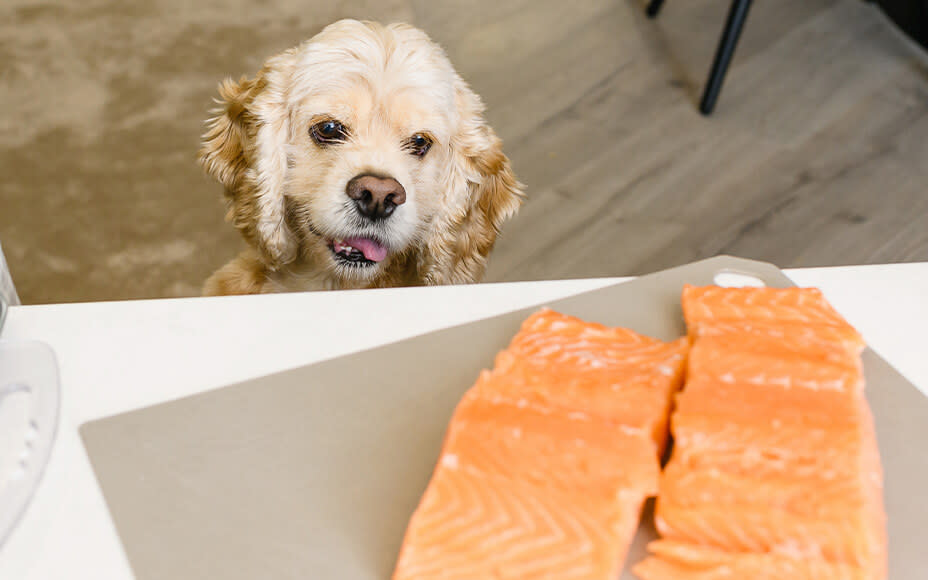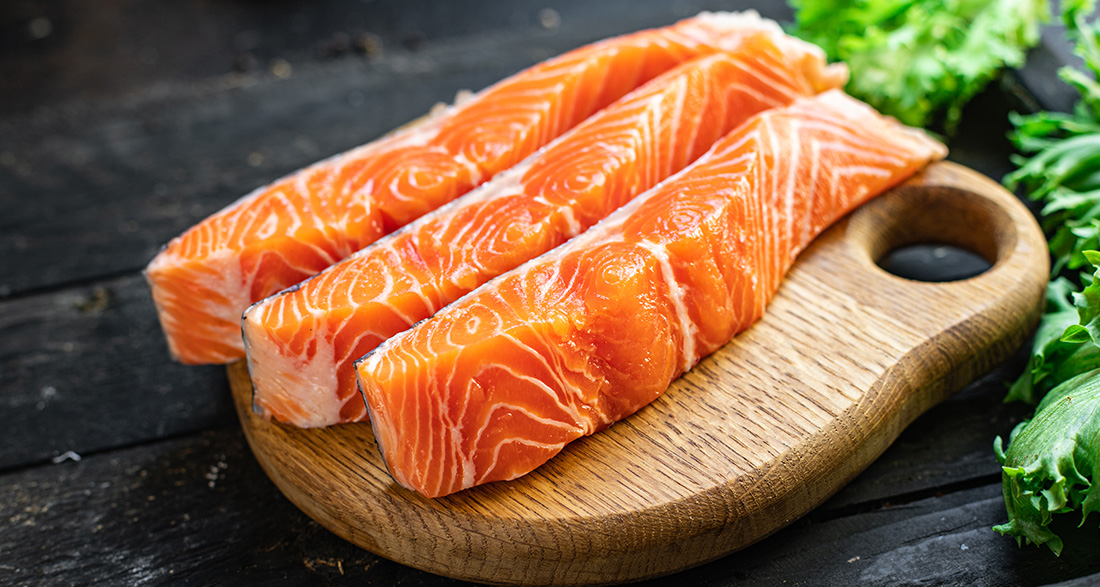Can dogs eat salmon, and what should be considered when feeding them? Should salmon be fed to dogs raw, smoked, or cooked? Learn more on the topic.
Is Salmon Allowed and Healthy for Dogs?
Salmon is fresh and healthy—or rather, fish is healthy. With its numerous health benefits for humans, the question arises whether your dog can also eat salmon? Yes, dogs can eat salmon, in addition to sardines, and even on a daily basis. Salmon serves as an ideal source of protein in their diet, providing essential nutrients. Discover what to consider when feeding salmon and why it’s so beneficial for your furry friend’s health.
Why is Salmon So Healthy for Dogs?
In addition to providing healthy protein for daily energy, salmon brings along other essential vitamins and minerals for your four-legged companion:
- Omega-3 Fatty Acids: These essential fatty acids are crucial for life (e.g., for brain function and the immune system) but cannot be produced by the body. Therefore, intake through food is essential. These fatty acids are also important for skin and coat health, maintaining a healthy cholesterol level, and alleviating inflammation. If your dog experiences skin and coat issues like excessive shedding, itching, dandruff, or a dull coat, an appropriate diet can help.
- Vitamin D: Salmon also provides essential vitamin D, supporting bone metabolism. A deficiency can lead to joint problems and osteoporosis. Animals with a vitamin D deficiency are also more susceptible to infections, as vitamin D protects the immune system.
- Vitamin B12: For the formation of new blood cells and nerve cells, your dog’s body needs vitamin B12. A deficiency can lead to limitations in nerve function, weakness, anemia, and central nervous system disorders.
- Vitamin E: This important vitamin helps the body protect against free radicals. Vitamin E, in particular, protects and strengthens skin cells.
- Vitamin A: Vitamin A contributes to healthy cell growth and vision.
Even during training, your furry friend can benefit from these advantages! Our salmon snacks are not only super tasty but also provide essential fatty acids, vitamins, and minerals!

Which Salmon is Best for Dogs?
Not all salmon is the same—salmon is divided into wild-caught salmon, farmed salmon, and pollock.
Wild-Caught Salmon, as the name suggests, comes from free waters. Active and naturally raised in their habitat, this salmon is by far the healthiest choice for your dog. Free from medications, with the best flavor and low fat content, it does carry the risk of parasites. However, cooling, cooking, or frying can make them harmless.
Farmed Salmon, as the name implies, can be understood as the opposite of wild-caught salmon. Over generations, the salmon has been altered for years, making it significantly different from the tasty wild-caught variety. Similar to poultry in cage farming, farmed salmon has little space, making it inactive and high in fat. While your furry friend cannot contract parasites through antibiotics given in farming, they absorb parts of the medication through the food, and the content of essential omega-3 fatty acids is lower here.
Pollock is the salmon that would like to be one but simply isn’t. So, you could say that this is a genuine substitute salmon. If you see “Alaska pollock” in the supermarket, now you know what it actually is: Cod in salmon coating. Huh? Exactly, because in appearance, the pink-orange chemically colored cod meat resembles salmon, which is why it is often treated as a substitute.
The balance of the three types is clear: wild-caught salmon is likely the winner—both due to its natural development and nutrient composition. However, it also costs the most, so you may need to dig a little deeper into your pocket.
Raw or Smoked: How Do I Feed Salmon to My Dog?
The fishier, the better—or something like that! You should feed salmon and fish in general as fresh as possible. If the good sea creature has been stored for a while, there is a risk of bacteria and germs forming, which can be transmitted to your dog.
Salmon can be fed raw without any issues—only with continuous refrigeration and for immediate feeding. Especially when BARFing, it’s about fresh feeding of meat or fish, enhanced with fruits, vegetables, herbs, and →oils.
No flax, no dog wants old salmon! If the fish is not quite as fresh but still edible, you can offer it to your dog cooked or fried. Remember that bones must be removed beforehand, and spices should be avoided. For your furry friend, the pure taste of natural salmon is already very attractive!

And what about smoked salmon? It is too salty for your dog in large portions. Moreover, the smoking process introduces toxins into the meat, making this salmon unsuitable for regular feeding. A small bite here and there is harmless and not toxic, but it’s best to opt for fresh salmon.
Most dogs are crazy about the intense taste of salmon. If you don’t want to change their diet, salmon oil can perfectly enhance their meals and provide valuable polyunsaturated fatty acids!
How Often Can My Dog Have Salmon?
Salmon can take a place in your dog’s menu every day as desired. You can choose a healthy complete food for your furry friend, such as our salmon wet food with rice, peas, and potatoes or the dry food with Scottish salmon, dill, spinach, and fennel. Here, you can be sure that your pet will be provided with the best gourmet delight and can enjoy the health benefits of salmon!
If you feed salmon in addition to regular food, you don’t have to adjust the amount immediately for one or two pieces. However, to avoid overfeeding and obesity, you should reduce the amount of food according to the feeding recommendations.
Can My Dog Eat Salmon Skin?
Salmon skin represents a particularly vitamin-rich treat for your dog. But beware: Dogs with more “hip gold” should not indulge too much in this delicious skin, as it is very rich in fat. With our delicious salmon skin rolls, your furry friend can enjoy extra-long chewing fun!


